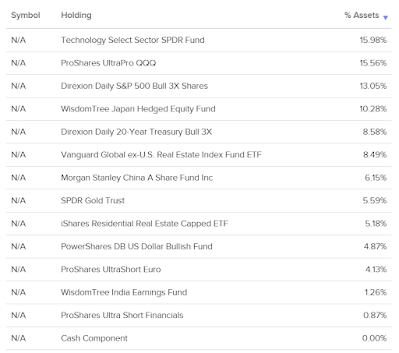Over the last couple of months or so, we've been talking about how the crazy high yielding, single stock, covered call ETFs are not proxies for their underlying or reference securities. Instead, they are products that sell the volatility of their underlying or reference securities. Big difference. Obviously to buy one of the crazy high yielders, you should be favorably disposed to the underlying but they should not be expected to track the underlying which is ok if you realize that going in.
Maybe we should take a similar approach to 2x and 3x levered long ETFs. Other than the ProShares 2x S&P 500 (SSO), most of these funds stray wildly from their reference securities. The boiler plate for these funds all say not to hold long term, other than a few from Tradr which target longer reset periods, and I am not saying that these funds don't stray wildly, quite the opposite they do. SSO seems to be pretty close much of the time as an exception of sorts.
Maybe there is a better way to think of these than how close they are or are not to their underlying. Where crazy high yielding, single stock, covered call ETFs are products that sell the volatility of their underlyings, maybe the 2x and 3x levered long ETFs are products that combine the return of the underlying with buying the volatility of the underlying.
Working this theory through, the ProShares 3x Leveraged S&P 500 ETF (UPRO) tracks SPY plus a measure of SPY's volatility. That's a different thing that at times might resemble 3x times the return of SPY but there will be plenty of times it will not. For purposes of this post, forget tracking SPY, think about equity plus volatility, realizing that at times the volatility will help the portfolios and that at times it will hurt the portfolio. The mindset is completely different than how just about everyone views these funds. Borrowing PIMCO's naming convention, these could be StocksPLUS Volatility. That framework isn't that different than an individual stock you might buy. At times, that stock will help and at other times it will hurt.
When I was at AdvisorShares, the Morgan Creek Global Tactical ETF (GTAA) maintained positions in levered ETFs for an extended period. VettaFi has info on GTAA even though it closed in 2017.
The reported three year return number was not good but the consequence was opportunity cost as opposed to permanently impairing capital. It looks like GTAA leveraged up quite a bit without trying to do a lot to offset volatility.
Borrowing a little from GTAA, I came up with the following which makes some effort to help manage volatility.
And comparing it to plain vanilla 60/40 at represented by VBAIX.
The improved CAGR is pretty much matched by the increase in volatility but the Sharpe Ratio improvement is surprising. When I plug all that into Portfoliovisualizer, it has the the levered portfolio with a much better kurtosis number meaning, despite the huge weightings to 3x funds, the vulnerability to large drawdowns is less. BTAL and the Merger Fund are client and personal holdings.
The levered portfolio did slightly worse in 2022 but not catastrophically worse despite UPRO falling 56% and TYD falling 43%.
Sticking with the theory, the Levered Portfolio is not just in equities, intermediate treasuries, managed futures, hedged, merger arb and floating rate, it is invested in all those things plus a lot of equity volatility which may or may not look like equities and a lot of treasury volatility which may or may not look like treasuries.
When the expectation is that UPRO won't track SPY, it's no longer something to worry about. When the expectation is that TYD won't track IEF, it's no longer something to worry about.
The catalyst for this post was a quote in Barron's by Bryan Armour from Morningstar who said of levered ETFs, "I don't think anyone should own them." Broad proclamations about what everyone should or should not do are just lazy.
The point is not necessarily to use levered funds, I think this would be a tough way to make a living but there is tremendous value in looking at things differently than how the consensus does. I can't imagine the portfolio we created today is reasonably optimal but as far back as we can backtest, a lot of different types of market events have happened and it made it through without calamity. The levered funds are not proxies for the underlying, they are the underlying plus a lot of volatility which have different performance numbers and different volatility profiles than the underlying reference securities.
The information, analysis and opinions expressed herein reflect our judgment and opinions as of the date of writing and are subject to change at any time without notice. They are not intended to constitute legal, tax, securities or investment advice or a recommended course of action in any given situation.







2 comments:
Great article, Roger. Excellent point on thinking differently than the consensus.
Thank you!
Post a Comment